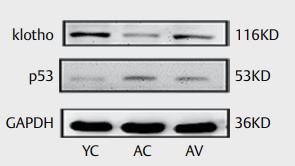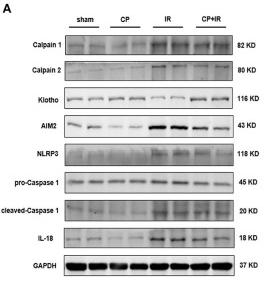Klotho Antibody - #DF10309
| 製品: | Klotho Antibody |
| カタログ: | DF10309 |
| タンパク質の説明: | Rabbit polyclonal antibody to Klotho |
| アプリケーション: | WB IHC |
| Cited expt.: | WB |
| 反応性: | Human, Mouse, Rat |
| 予測: | Bovine, Horse, Sheep, Dog, Chicken |
| 分子量: | 116kDa; 116kD(Calculated). |
| ユニプロット: | Q9UEF7 |
| RRID: | AB_2840887 |
製品説明
*The optimal dilutions should be determined by the end user. For optimal experimental results, antibody reuse is not recommended.
*Tips:
WB: For western blot detection of denatured protein samples. IHC: For immunohistochemical detection of paraffin sections (IHC-p) or frozen sections (IHC-f) of tissue samples. IF/ICC: For immunofluorescence detection of cell samples. ELISA(peptide): For ELISA detection of antigenic peptide.
引用形式: Affinity Biosciences Cat# DF10309, RRID:AB_2840887.
折りたたみ/展開
Kl; KLOT_HUMAN; Klotho peptide;
免疫原
A synthesized peptide derived from human Klotho, corresponding to a region within the internal amino acids.
Present in cortical renal tubules (at protein level). Soluble peptide is present in serum and cerebrospinal fluid. Expressed in kidney, placenta, small intestine and prostate. Down-regulated in renal cell carcinomas, hepatocellular carcinomas, and in chronic renal failure kidney.
- Q9UEF7 KLOT_HUMAN:
- Protein BLAST With
- NCBI/
- ExPASy/
- Uniprot
MPASAPPRRPRPPPPSLSLLLVLLGLGGRRLRAEPGDGAQTWARFSRPPAPEAAGLFQGTFPDGFLWAVGSAAYQTEGGWQQHGKGASIWDTFTHHPLAPPGDSRNASLPLGAPSPLQPATGDVASDSYNNVFRDTEALRELGVTHYRFSISWARVLPNGSAGVPNREGLRYYRRLLERLRELGVQPVVTLYHWDLPQRLQDAYGGWANRALADHFRDYAELCFRHFGGQVKYWITIDNPYVVAWHGYATGRLAPGIRGSPRLGYLVAHNLLLAHAKVWHLYNTSFRPTQGGQVSIALSSHWINPRRMTDHSIKECQKSLDFVLGWFAKPVFIDGDYPESMKNNLSSILPDFTESEKKFIKGTADFFALCFGPTLSFQLLDPHMKFRQLESPNLRQLLSWIDLEFNHPQIFIVENGWFVSGTTKRDDAKYMYYLKKFIMETLKAIKLDGVDVIGYTAWSLMDGFEWHRGYSIRRGLFYVDFLSQDKMLLPKSSALFYQKLIEKNGFPPLPENQPLEGTFPCDFAWGVVDNYIQVDTTLSQFTDLNVYLWDVHHSKRLIKVDGVVTKKRKSYCVDFAAIQPQIALLQEMHVTHFRFSLDWALILPLGNQSQVNHTILQYYRCMASELVRVNITPVVALWQPMAPNQGLPRLLARQGAWENPYTALAFAEYARLCFQELGHHVKLWITMNEPYTRNMTYSAGHNLLKAHALAWHVYNEKFRHAQNGKISIALQADWIEPACPFSQKDKEVAERVLEFDIGWLAEPIFGSGDYPWVMRDWLNQRNNFLLPYFTEDEKKLIQGTFDFLALSHYTTILVDSEKEDPIKYNDYLEVQEMTDITWLNSPSQVAVVPWGLRKVLNWLKFKYGDLPMYIISNGIDDGLHAEDDQLRVYYMQNYINEALKAHILDGINLCGYFAYSFNDRTAPRFGLYRYAADQFEPKASMKHYRKIIDSNGFPGPETLERFCPEEFTVCTECSFFHTRKSLLAFIAFLFFASIISLSLIFYYSKKGRRSYK
種類予測
Score>80(red) has high confidence and is suggested to be used for WB detection. *The prediction model is mainly based on the alignment of immunogen sequences, the results are for reference only, not as the basis of quality assurance.
High(score>80) Medium(80>score>50) Low(score<50) No confidence
研究背景
May have weak glycosidase activity towards glucuronylated steroids. However, it lacks essential active site Glu residues at positions 239 and 872, suggesting it may be inactive as a glycosidase in vivo. May be involved in the regulation of calcium and phosphorus homeostasis by inhibiting the synthesis of active vitamin D (By similarity). Essential factor for the specific interaction between FGF23 and FGFR1 (By similarity).
The Klotho peptide generated by cleavage of the membrane-bound isoform may be an anti-aging circulating hormone which would extend life span by inhibiting insulin/IGF1 signaling.
N-glycosylated.
Cell membrane>Single-pass type I membrane protein. Apical cell membrane>Single-pass type I membrane protein.
Note: Isoform 1 shedding leads to a soluble peptide.
Secreted.
Secreted.
Present in cortical renal tubules (at protein level). Soluble peptide is present in serum and cerebrospinal fluid. Expressed in kidney, placenta, small intestine and prostate. Down-regulated in renal cell carcinomas, hepatocellular carcinomas, and in chronic renal failure kidney.
Contains 2 glycosyl hydrolase 1 regions. However, the first region lacks the essential Glu active site residue at position 239, and the second one lacks the essential Glu active site residue at position 872.
Belongs to the glycosyl hydrolase 1 family. Klotho subfamily.
研究領域
· Metabolism > Carbohydrate metabolism > Pentose and glucuronate interconversions.
· Metabolism > Global and overview maps > Metabolic pathways.
· Organismal Systems > Aging > Longevity regulating pathway. (View pathway)
· Organismal Systems > Excretory system > Endocrine and other factor-regulated calcium reabsorption.
参考文献
Application: WB Species: Mouse Sample: kidney
Application: WB Species: mouse Sample: gastrocnemius
Application: WB Species: human Sample: human umbilical vein endothelial cells
Restrictive clause
Affinity Biosciences tests all products strictly. Citations are provided as a resource for additional applications that have not been validated by Affinity Biosciences. Please choose the appropriate format for each application and consult Materials and Methods sections for additional details about the use of any product in these publications.
For Research Use Only.
Not for use in diagnostic or therapeutic procedures. Not for resale. Not for distribution without written consent. Affinity Biosciences will not be held responsible for patent infringement or other violations that may occur with the use of our products. Affinity Biosciences, Affinity Biosciences Logo and all other trademarks are the property of Affinity Biosciences LTD.





